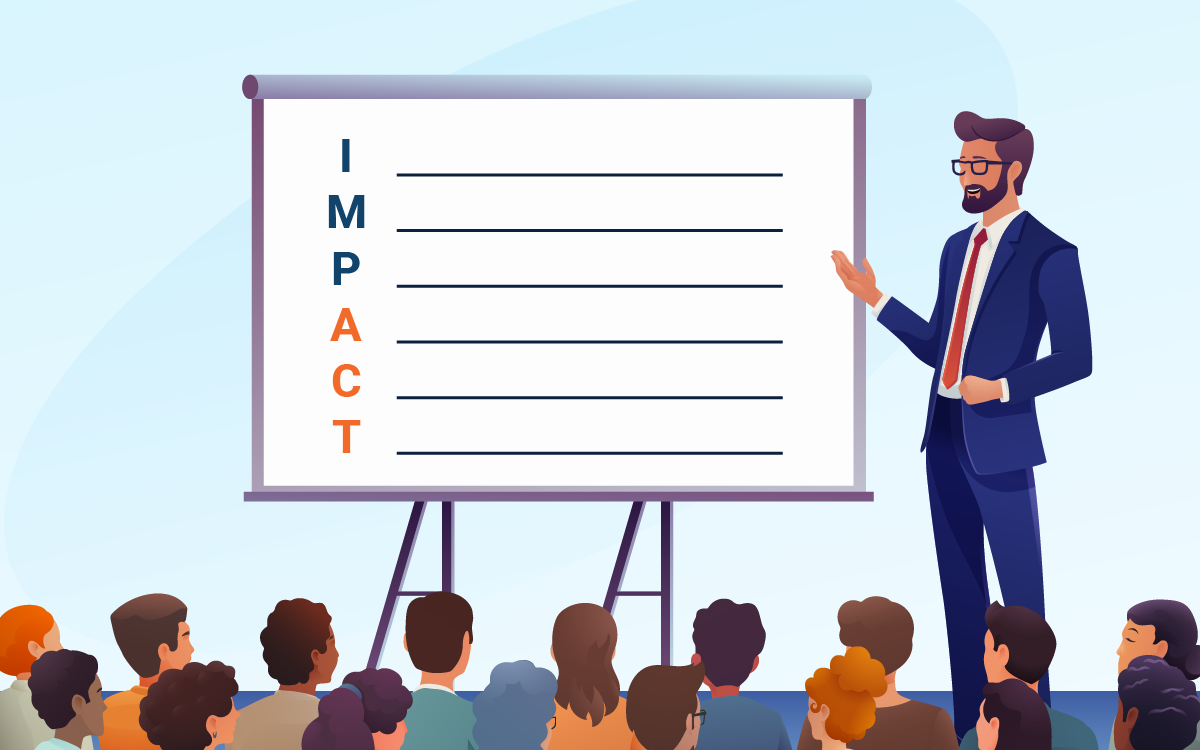In today’s competitive selling environment, having a consistent, repeatable sales process is critical for qualifying prospects, communicating value, and driving revenue growth. That’s why leading sales organizations turn to The Brooks Group’s IMPACT Selling sales team training to equip their teams with proven selling skills that get measurable results.
Ready to improve sales team performance? Learn more about IMPACT Selling.
What is IMPACT Selling?
IMPACT Selling is a six-step consultative sales approach that’s straightforward and buyer focused. This sequence guides sales professionals through strategic milestones while providing proven techniques to navigate each buyer interaction with confidence.
What are the benefits of bringing IMPACT Selling to my organization?
1. IMPACT drives consistency and predictability.
Without a defined process, sales professionals are left to their own approaches, which can lead to inconsistent results. A proven methodology ensures everyone follows the same best practices for pipeline management, opportunity qualification, discovery, presenting, negotiating, and closing. This levels the playing field and makes sales cycles and revenue more predictable.
2. IMPACT improves sales effectiveness and efficiency.
An established sales process eliminates wasted time and effort by providing a roadmap for salespeople to follow. They know exactly which activities to prioritize at each stage, allowing them to progress deals forward in line with the buyer’s process. This results in higher velocity through the funnel and increased sales effectiveness.
3. IMPACT improves customer experience.
Customers appreciate a professional, consultative sales approach. Having a process centered on asking the right questions, truly understanding needs, and providing tailored, value-based solutions enhances the buying experience. This positions the salesperson as a credible, trusted advisor rather than a transactional vendor.
4. IMPACT aligns the entire sales team.
When everyone follows the same process, it promotes unity, communication, and collaboration across the sales force. Team members speak the same language, can strategize together more seamlessly, and can even smoothly hand off opportunities between each other if needed.
5. IMPACT accelerates onboarding of new sales hires.
Rather than learning anecdotal and inconsistent institutional knowledge, new hires get immersed in the company’s standard selling methodology and toolset from day one. This ramps them up to full productivity faster.
6. IMPACT provides a framework for sales coaching and accountability.
With a defined sales process, sales leaders have a benchmark for evaluating performance, identifying skill gaps, and providing sales coaching to improve adherence in areas such as discovery, presentations, or negotiating.
How will it impact profitability?
The Brooks Group uses a comprehensive data-driven approach to improving sales performance that connects training initiatives to business outcomes. Our solution diagnoses selling skills gaps and delivers sales training to fill those gaps, reinforce proficiency, validate improvement, and deliver the highest ROI.
Companies using IMPACT Selling report measurable sales improvements after training:
- 67X ROI one-year post training, with a six-month payback period
- 74X ROI of training with reinforcement, with a three-month payback period
- 14% increase in average sale amount
- 22% increase in conversion rate
- 13% decrease in sales cycle length
What’s the sales process?
IMPACT is an acronym representing the six stages of the sales process: Investigate, Meet, Probe, Apply, Convince, Tie-It-Up. Sales professionals learn best practices for progressing the sale at each step:
- Investigate: Prospecting, Pre-Call Planning and Positioning
- Meet: Developing Rapport and Building Trust
- Probe: Identifying Customer Needs and Wants
- Apply: Recommending the Right Solution
- Convince: Managing Objections, Negotiating, and Proving Value
- Tie-It-Up: Closing and Managing Next Steps
What goals does IMPACT Selling accomplish?
IMPACT Selling empowers sales leaders to:
- Gain Clarity: Assess the current proficiency of every sales professional in your organization and get clear visibility into the top performance gaps impacting revenue results.
- Benchmark Sales Excellence: Define capabilities of high-performing sales professionals in your industry and connect performance metrics to business outcomes.
- Forecast Accurately: Apply a proven, consistent process that ensures everyone follows the same best practices and makes sales cycles and revenue more predictable.
- Unlock Sales Potential: Leverage award-winning sales training that prioritizes and reinforces the capabilities each seller needs to achieve goals and drive sales performance.
Why is IMPACT Selling a good investment?
Training a sales team on a repeatable sales process injects discipline, skill, and confidence into your selling approach, so forecasts are more reliable, revenues more predictable, and customers more satisfied. It’s foundational to effective sales enablement.
Winning sales teams, even those from different industries, have one thing in common: They use a repeatable sales process. As a result, they’re consistent, they follow best practices, they replicate the habits of their A-players, and they reinforce the process with sales team training.
Research shows that sticking with a sales process correlates with success. Sales teams that don’t follow their sales process find it difficult to meet sales goals.
Data from our Best Practices of Winning Sales Teams report shows:
- 95% of teams that met or exceeded revenue goals follow their sales process all or most of the time.
- Only 69% of underperforming teams follow their sales process.
Companies using IMPACT Selling see measurable sales performance improvements, including:
- Increased sales revenue and margins
- Shortened sales cycles
- Better buyer communications and stronger relationships
- Greater strategic focus
- Increased efficiency
- Seamless application to real-world selling
Why does it work?
At its core, IMPACT Selling uses a consultative sales strategy to empower sales professionals. The program teaches probing questioning skills to deeply understand customers’ needs and challenges up-front.
They then apply this knowledge to present the best product solution and overcome objections. The process culminates in negotiating a mutually beneficial close while laying the groundwork for future sales.
The IMPACT sales training program begins with a sales assessment of each participant to understand their behavioral patterns, communication styles, and decision-making processes. The Brooks Talent Index® assessment reveals individual preferences and gives sales leaders a valuable tool for managing, coaching, and developing their team as a whole.
What is it based on?
IMPACT Selling follows a tested, proven sales process. Over two immersive days, training participants become proficient at fundamental selling skills such as qualifying opportunities faster, becoming a trusted advisor through advanced questioning, identifying and adapting to buying styles, presenting value over price, building loyalty, and more.
Unlike theoretical training, IMPACT is laser-focused on immediately applicable tools and techniques developed and used by top sales performers. Through instructor-led sessions, role-plays, assessments, and more, sales teams walk away with approaches they can apply right away.
Unlock Sales Team Potential
Whether you have a team of seasoned pros or new talent in need of guidance, IMPACT Selling provides the foundation for more consistent, high-impact selling performance across your entire sales organization.
See how IMPACT Selling training programs can improve sales performance.




